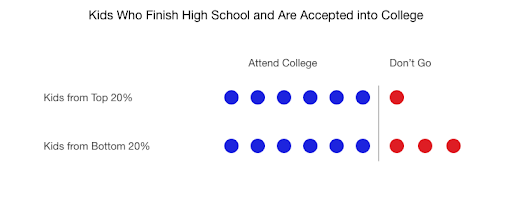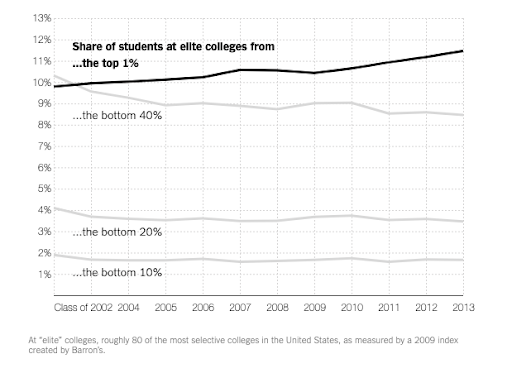College graduates are likely to earn almost double the average salary of high school graduates, so making sure every child has an equal chance to walk on graduation day is extremely important for our economy. If kids of low socioeconomic status have less chance to graduate from college, then our society breaks a promise to children — the American Dream — that anyone can work hard and access improved economic outcomes, and that they do in fact have equal opportunities. By failing to provide the tools necessary to make the American dream a reality, we squander a crucial opportunity to live up to our ideals as a country.
Over half of college graduates come from families in the top 20%, leaving everyone else with significantly reduced earning potential. Earning a degree is a major path to improved earnings, so if hard workers consistently are unable to access the opportunity to earn a college degree, we uphold a system that lacks social or financial mobility.
Over the last few weeks we’ve looked at a few different approaches to understanding what causes the inequity as well as some potential solutions. Now that we have all the pieces, I’d like to put them together so we can see what we can and should do to help.
Does class provide intrinsic educational advantages that our system can’t possibly counterbalance?
Many believe that the fundamental problem with educational achievement is based on class, not our system.
For instance, the classist argument will point out that kids from more affluent households develop better vocabularies. Parents have more resources both in terms of time and money to spend with kids, so there is more opportunity for language development. This has been validated by research. But while it would be challenging to counteract the vocabulary advantage, there are other areas of difference that we can more easily correct to make our system fairer for everyone. These are summer melt and college choice.
Two small problems that cause the largest impact
Summer melt describes what can happen to less affluent kids between being accepted to and attending their college of choice. The term applies to students whose kids graduate from high school and received admission to college, but for some reason they didn’t end up enrolling . Kids from the top 20% of income sometimes fall off the track at this time too, but they are much less likely to do so. If we could even the odds here and reduce summer melt, then we would see more equal representation on Graduation Day.
- For every 6 kids [accepted to college] from families in the top 20% of earners [who enroll], there is 1 kid who does not enroll in college.
- For every 6 kids [accepted to college] from families in the bottom 20% who enroll, there are 3 who do not attend.*
*The National Center for Education Statistics, 2016
What stops these kids from enrolling? Lack of guidance. Only 39% of kids from low-income families have a parent who completed some college (“Parents’ Low Education Leads to Low Income, Despite Full-Time Employment”, 2007). Many of them must manage all the forms, finances and logistics themselves. These complex decisions can be overwhelming.
We can see how this creates a self-fulfilling prophecy. College graduates earn more on average and are more likely to climb further up the financial ladder. This leaves households of low socioeconomic status with a dearth of financial and informational resources to help their kids get into college.
As hard as it is to look at the structural disadvantages of some students face through no fault of their own, this insight is incredibly helpful in formulating ways to reduce summer melt and make the system fairer for everyone.
Unfortunately summer melt is not the only point of difference where we see more kids with fewer family resources fall off the college path.
A matter of choice
To understand what is really happening during college we need to be prepared for a bit of discomfort. Dropout rates are significantly higher for kids from poorer families. But again, we need to examine this fact more closely to understand what is really happening. If we look at any individual school we don’t see any difference. It just happens that more affluent families send their kids to selective, four-year, nonprofit institutions. These institutions invest more resources in mentorship and guidance to ensure their kids graduate successfully.
In fact many elite institutions have more students from the top 1% in their student body than the bottom 40%, and the ratio is actually getting worse.

* Still from “Some Colleges Have More Students from the Top 1 Percent than the Bottom 60. Find Yours.” The New York Times, 18 Jan. 2017, https://www.nytimes.com/interactive/2017/01/18/upshot/some-colleges-have-more-students-from-the-top-1-percent-than-the-bottom-60.html?action=click&contentCollection=Opinion&module=Trending&version=Full®ion=Marginalia&pgtype=article
This is a problem because many of the schools the top earners attend — selective 4-year nonprofit institutions — devote more resources toward ensuring their students graduate. The most selective institutions graduate more than 90% of their students while many public universities graduate 60% or more of their students. The University of Colorado for example graduates close to 70%.
However, 2-year and for-profit institutions graduate an average of 40% of their freshman class. Those odds are simply unacceptable, especially when they lead to social immobility on a national scale.
Any one of these barriers would be unfair, but all of them together create a system that violates our collective belief in financial mobility. Economists are in consensus about the value of social mobility, but it doesn’t take a theoretical argument to see how educational inequity hurts Colorado.
Colorado depends on out-of-state educational systems and pays for it
Approximately ¾ of our jobs in Denver require college degrees, but only ¼ of our students are on track to get one; we fill that gap with talent from out-of-state. There are significant costs associated with bringing in out-of-state talent: moving expenses, extra salary required to entice a recent graduate to move across the country, and more. All of these things increase the cost of doing business, which in turn amplifies the cost of living (and population density), reduces our competitiveness and increases our poverty rate.
Graduating more Colorado kids from college would ameliorate much of this pain. We would improve the income level of our state residents while reducing the expense of employment.
How can we improve education in Colorado?
First we need to recognize the inequity of the education system. It isn’t anyone’s fault, but capitalism is not working for everyone. Fortunately, there are steps we can take to solve it at the local level.
The country’s most selective institutions already know that it takes consistent mentorship to keep students on the path toward graduation. The support systems they have put into place work to double the odds of graduating, and similar interventions have helped kids successfully enroll too.
At Minds Matter, we pair mentors with college experience and high schoolers who need that guidance. And you know what? It works. The students we mentor enroll in college and graduate successfully. I can’t think of a better way to show how we can give every child a fair chance here in Colorado than to put our hypothesis to the test by providing mentorship for more kids who need it.
Learn more about Minds Matter Denver.
